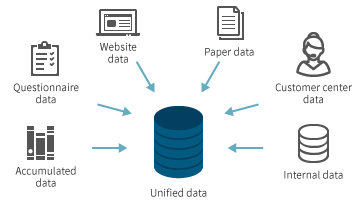CRM stands for Customer Relationship Management. It makes encounters with new customers, and gradually deepens relationships with them to be regular customers. CRM takes different actions according to preferences and behavior patterns of each customer group. It is different from mass marketing that send same message to everyone.
CRM is a medium and long term ongoing activity that does not show significant results as soon as it starts. But it contributes to generate regular customers by continuing, and these regular customers can be your strength which your competitors don’t have.
The first thing you need is to know about your customers. Customer data is indispensable for that. The following is an example of customer data.
(Basic profile)
Name, Email address, Phone number, Address, Gender, Age, Occupation etc.
(Purchase information)
Product, Purchase price, Purchase place, Warranty situation etc.
(Access information)
Usage of website (Login history, Browsing history of website contents, etc.)
If customer data exist at hand, there are many cases that preparation for these data is needed in advance. Even if customer data exist at hand, there are many cases that preparation for these data is needed in advance. For example, there are many data internally with different format such as in digital like CSV and excel, and in paper like questionnaire, warranty card etc.
In such a case, it is necessary to consolidate the data format and clean data that can not be used. This is important preparations for CRM.

If you do not own customer (=end user) data yet, the first thing need to do is to create a mechanism that accumulates customer data at your side.
(Examples of the mechanism)
We design and develop these website with keeping in mind "utilization of customer data to CRM".
After customer data is ready, we analyze data to grasp current trend of customer purchase behavior. In order to implement an effective CRM, visualization of customers is important. By this analysis, we can think answers to these questions like "What kind of customers are easy to purchase products in this price range?" "Which customers are proper that we send cross-sell/ up-sell message?" etc.
After data analysis, we make a communication plan includes “to who (= customer segmentation), what action we expect (= objective), what kind of message (= content), how to deliver (= communication method: e.g. email, phone, SNS, SMS, advertising)” based on the analysis results.
After communication plan created, communication tools such as direct mail, email, online campaign application form, banner image, etc is needed. These items should be effective for target customers. After prepared, send message to each customers.
Check the actual result such as email open rate, number of campaign participants, etc by comparing with KPI.
Guess the factors that behind the actual results above, and utilize it for improvement. Normally there are multiple factors behind the result, such as customer segments, contents, communication method, timing, user-friendliness that leads users for conversion. To achieve effective CRM, this result analysis is most important.
The effective CRM operation method varies depending on the country and region. We can support CRM operation by considering the local society, the local business environment and the local customer viewpoint with our accumulated business experiences in the local market.